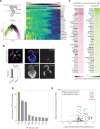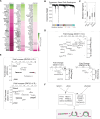This is a preprint.
Arrayed single-gene perturbations identify drivers of human anterior neural tube closure
- PMID: 40777478
- PMCID: PMC12330715
- DOI: 10.1101/2025.07.21.665862
Arrayed single-gene perturbations identify drivers of human anterior neural tube closure
Abstract
Genetic studies of human embryonic morphogenesis are constrained by ethical and practical challenges, restricting insights into developmental mechanisms and disorders. Human pluripotent stem cell (hPSC)-derived organoids provide a powerful alternative for the study of embryonic morphogenesis. However, screening for genetic drivers of morphogenesis in vitro has been infeasible due to organoid variability and the high costs of performing scaled tissue-wide single-gene perturbations. By overcoming both these limitations, we developed a platform that integrates reproducible organoid morphogenesis with uniform single-gene perturbations, enabling high-throughput arrayed CRISPR interference (CRISPRi) screening in hPSC-derived organoids. To demonstrate the power of this platform, we screened 77 transcription factors in an organoid model of anterior neurulation to identify ZIC2, SOX11, and ZNF521 as essential regulators of neural tube closure. We discovered that ZIC2 and SOX11 are required for closure, while ZNF521 prevents ectopic closure points. Single-cell transcriptomic analysis of perturbed organoids revealed co-regulated gene targets of ZIC2 and SOX11 and an opposing role for ZNF521, suggesting that these transcription factors jointly govern a gene regulatory program driving neural tube closure in the anterior forebrain region. Our single-gene perturbation platform enables high-throughput genetic screening of in vitro models of human embryonic morphogenesis.
Keywords: Stem cell; bioengineering; high-throughput; human; morphogenesis; neural tube; organoids; reproducible.
Conflict of interest statement
Declaration of Interests S.R., G.A., and R.H. are authors on the following patent application, which contains aspects of this work: “Bioengineering and machine learning framework for complex tissue development.” Application serial number PCT/US24/28838.
Figures





References
Publication types
Grants and funding
LinkOut - more resources
Full Text Sources
